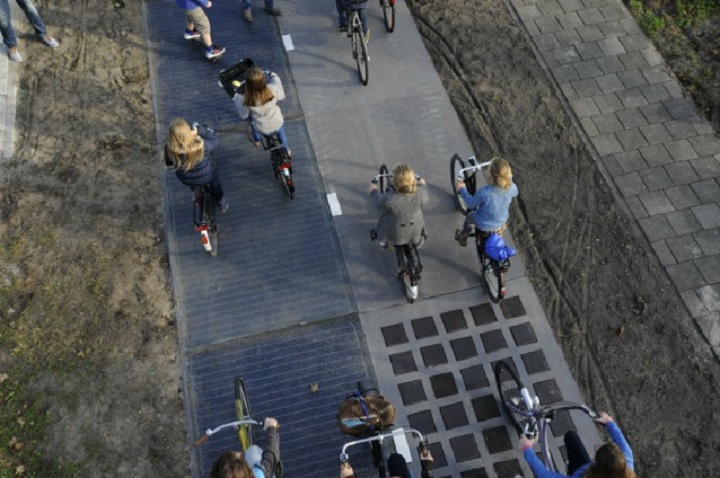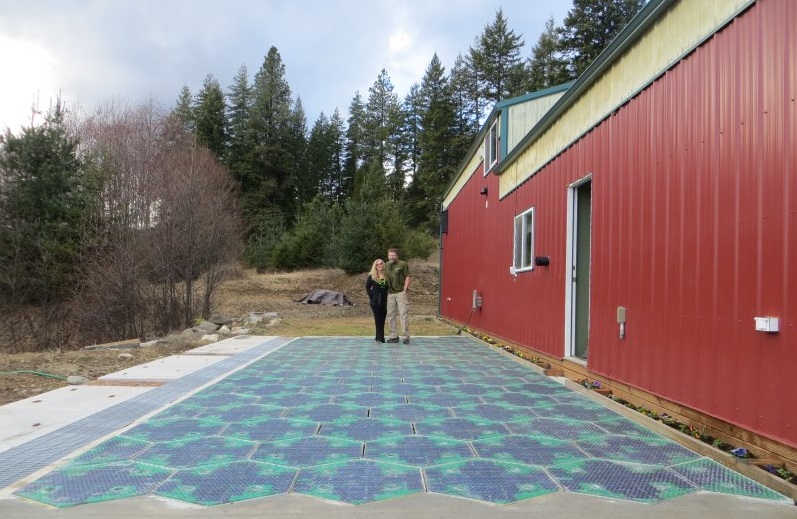
Last year, Scott and Julie Brusaw made headlines when they went public with their idea for building solar-powered LED roadways. Despite skepticism that such a concept would never be practicle, the couple managed to successfully raise $2,249,654 USD (of their original goal of $1 million ) via Indiegogo to finance the construction of their project.
This was just the latest in a long line of sucessful backings for the couple. In 2009, the Brusaws secured a $100,000 grant from the Department of Transportation for their company, Solar Roadways. In February 2010, they built their first panels, a 3.65 x 3.65 meter (12 by 12-foot) array without solar cells, to test whether the underlying electronics would work.
That same year, Solar Roadways won a $50,000 community award through GE's Ecomagination Challenge, giving it another pool of money to keep experimenting. Then, in 2011, the DOT followed up its initial support with a $750,000 grant to assist Solar Roadways in developing a second "parking lot" demonstration array with solar cells, LED lights, and a heating system built in.

The 70m bikepath, which is the world's first, has generated more energy than expected. Credit: solarroadways.com
And as of November of last year, their company began constructing a 70-meter bike path which connects the suburbs of Krommenie and Wormerveer in Amsterdam. This path, which is used by some 2000 cyclists a day, has served as a prototype to test whether larger roadways would work. And after a six-month dry run, the roadway is performing even better than expected.
In short, the 70-metre test bike path has been generating 3,000 kilowatt-hours (kWh) worth of electricity, or enough energy to power a small household for a year. At this rate, and given its scalability, similar roadways could be built along residential roads or even highways, providing enough electricity to power entire neighborhoods or even towns.
"If we translate this to an annual yield, we expect more than the 70kWh per square metre per year," Sten de Wit, spokesman for SolaRoad, said in an interview with Tarek Bazley of Al Jazeera. "We predicted [this] as an upper limit in the laboratory stage. We can therefore conclude that it was a successful first half year."

The Bruslaws standing before the first prototype roadway, which they installed in their driveway. Credit: solarroadways.com
The three-year, 3.5-million Euro (($3.9 million USD) pilot project was a public-private partnership between the Dutch province of Noord-Holland and the engineering firms TNO, Ooms Civiel and Imtech. In addition to testing the roadway's electrical yield, it was also designed to test the materials in real-world conditions to see if they were as impact-resistant, glare-free, and skid-resistant as conventional asphalt.
So far, more than 150,000 cyclists have used the solar-generating part of the bike path, and they barely noticed any difference. The tests have shown that large temperature fluctuations cause the glass coating to shrink, causing part of it to peel off in early winter and early spring. But this coating has since been repaired, and engineers are in the "advanced stage" of the development of an improved top layer.
Much like the prototype the Brusaws built in their driveway, every solar panel in the bike path consists of a concrete paving slabs embedded with ordinary solar panels and LED lights. These panels are protected by a centimetre-thick layer of transparent, skid-resistant tempered safety glass that can reportedly support up to 113 metric tons (250,000-pounds) in weight..

Artist's concept for a highway system that uses the SolarRoad panels. Credit: solarroadways.com
Having proven that the technology works in a limited context, Solar Roadways hopes to test the technology on smaller municipal roads next. Currently, there are nearly 30,000 square kilometers (18,000 square miles) of roads in the US alone, not to mention as many as 2 billion parking spaces. That works out to some 50,000 square kilometers (31,000 square miles) of usable surface that is just soaking up sun all day long.
However, more tests will have to be conducted to see if the panels are durable enough to accomodate a high volume of automobiles and trucks. As Eric Weaver, a research engineer at the Federal Highway Administration’s research and technology department, told Greentech Media: "We can’t say that it would be safe for roadway vehicular traffic. Further field-traffic evaluation is needed to determine safety and durability performance."
Well, one can certainly hope that those tests prove that the technology is feasible for conventional roads and high-traffic areas. If so, we could be experiencing a solar revolution in a few years time where just about any surface can be converted into a power source. Urban centers would cease being part of the problem of living spaces that have a negative impact on the environment, and would effectively become part of the solution.
And be sure to check out this promotional video from Solar Roadways:
Top Image Credit: Green Tech Media
Sources:
- www.solarroadways.com/intro.shtml
- www.indiegogo.com/projects/solar-roadways/x/1964233
- www.aljazeera.com/news/2015/05/150510092535171.html
- www.sciencealert.com/world-s-first-solar-road-opens-in-the-netherlands
- thinkprogress.org/climate/2015/05/11/3657220/solaroad-producing-energy/
- www.cbc.ca/news/technology/solaroad-generates-more-power-than-expected-1.3069371
- www.sciencealert.com/solar-roads-in-the-netherlands-are-working-even-better-than-expected
- www.greentechmedia.com/articles/read/Department-of-Transportation-Official-Discusses-Solar-Roadways








